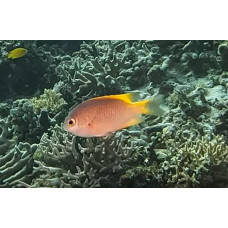Latin name
Pomacentrus lepidogenys
Other name
Pomacentrus lepidogenys
Identification
Scaly damselfish have a rounded, elongated body shape that is compressed at the sides. They have one nostril on each side and small sized ridged scales.
Features of fish fins
Dorsal spines (total): 13; Dorsal soft rays (total): 14 - 15; Anal spines: 2; Anal soft rays: 14 - 15.
Fish colouring
Blue-gray fish with yellow second dorsal and tail fins. Males are often a shade or two darker and may be covered with white spots during the mating season.
Distribution
Widespread in the Indo-West Pacific: including the Andaman Sea (Phuket), the Indo-Malay Archipelago, North Korea, and the islands of Melanesia and Tonga; occurs as far north as the Ryukyu Islands. In Japan.
Habitat
Marine tropical species. Depth from 1 to 12 meters. Adults inhabit lagoons, passages and outer slopes of reefs.
Size
The maximum length of this species is 9 cm.
Behavior
Occurs singly or in small groups. Diurnal. Does not migrate.
Food and feeding habits
Scaly damselfish feed on zooplankton in the water column near the bottom.
Reproduction
Egg-laying, mating during reproduction. Eggs are on the bottom and attached to the substrate. Males guard and aerate eggs.
Fishing
No commercial value and of no interest to fishermen.
Relationship with a person
Harmless.
| Classification | |
| Phylum | Chordata |
| Class | Actinopterygii |
| Squad | Perciformes |
| Family | Pomacentridae |
| Genus | Pomacentrus |
| Species | P. lepidogenys |
| Features | |
| Conservation status | Near Threatened |
| Habitat | Pelagic |
| Life span, years | No information |
| Maximum body weight, kg | No information |
| Maximum length, cm | 9 |
| Sailing speed, m/s | No information |
| Threat to people | Not edible |
| Way of eating | Planktonophage |
Scaly damsel
Tags: scaly damsel


